| |
“The film was directed by Clive Rees, whose only other cinematic directorial effort was When the Wales (sic) Came, which had a similar theme about an eccentric man living an isolated existence on an island. While Rees is not as well-known as Stanley Kubrick, Sellers insisted in interviews, that he was ‘every bit as good.’” |
| |
Reviewer, Richard Winters, Scopophilia Movie Blog* |
When I was barely into my teens, I had an experience that, up to that time, was the most exciting of my life. Being besotted with film and TV even then, I was given a chance to visit the set of a drama being produced at our local TV studio. It was the first ‘film set’ I’d ever seen and it entranced me. The closely examined phoniness of it, its ephemeral nature, walls held up by plywood struts and the odd way it faded into the starkness of the area that contained it, all aspects that gave flight to my imagination. If I really concentrate I can still smell it. What I learned that day is that nothing matters unless you’re looking through a viewfinder. Superman’s Fortress of Solitude, after all, was almost 100% polystyrene much to my father’s surprise when we visited Pinewood Studios in 1977, forty four years ago. Filmmaking was a very odd profession but I wouldn’t have it any other way. I mention this memory because there was an actor in this film set plying his trade. It gave me a retroactive thrill to remember meeting Peter Vaughan after seeing such eye-catching performances as the back-pained ogre in Time Bandits, one of the violent (and subsequently toe-less) townsfolk in Straw Dogs and his final role, as Maester Aemon in Game of Thrones. His was a face ubiquitous on British TV while I was growing up so knowing nothing about The Blockhouse, my eye was caught by his name and the names of three others of that extraordinary cast. More on the casting a little later.
The Blockhouse starts revealing what seems to be a prisoner-of-war camp next to the sea on D-Day, 6th June 1944. In reality this was the building of Hitler’s ‘Atlantic Wall’, a series of fortifications and firepower to repel an invasion of Nazi-occupied Europe, in this instance at Guernsey in the Channel Islands. Over half a million French workers were conscripted to the task over three years. As the one in charge of the other workers, Aufret is universally despised as a collaborator, the wartime euphemism for someone who did the Nazi bidding in controlling his own people. After hard manual labour and force-feeding themselves a truly underwhelming and stomach-turning cuisine, the men are startled by powerful guns firing from Allied ships in the Atlantic. A lone Spitfire swoops in and subjects the area to aerial bombardment. The workers flee from being collateral damage but a certain amount of carnage is inevitable. The men take shelter where they can and suddenly find themselves trapped in an underground store house as exits and entrances were reduced to impenetrable rubble by the bombardment. Initial fear among the six men turns to a short-lasting joy when they find that they have an almost unlimited supply of food and wine sealed inside with them. Almost as important is a stash of thousands of candles. This means that to survive they will almost certainly be constantly inebriated. The bulk of the film charts the deteriorating health and relationships between the men, all by soft candlelight. Some go insane, some bear it more than others, some become murderous. You can smell the stench coming off these men as they eke out a dark living, candle by candle. This is extreme cinema not in its horror (though the situation is indeed horrific) nor its explicit sex or violence. It’s extreme because of its relentlessly grim nature. No wonder US distribution companies wanted some respite by asking to cut outside every so often to see how the war was going. It would have felt like a much needed holiday.
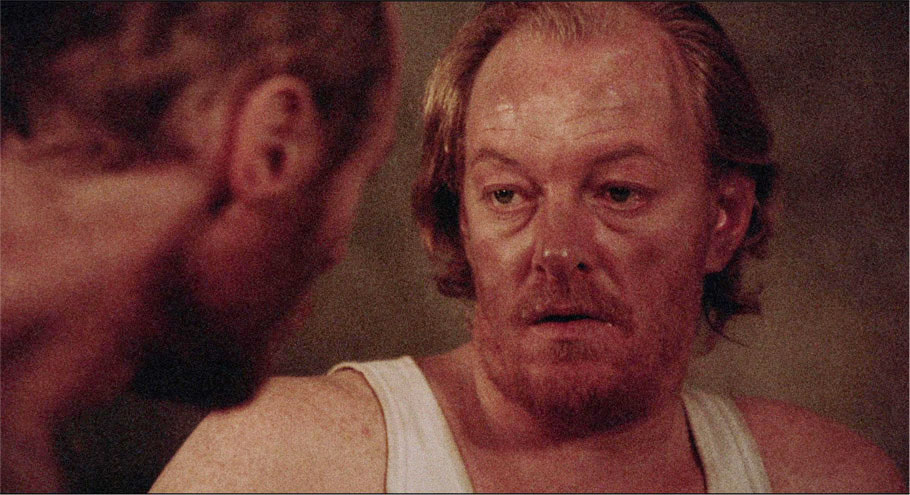
What sets the film apart from its studied grimness is the casting. Jeremy Kemp as Grabinski and Peter Vaughan as Aufret are probably the most recognisable character actors in the piece to someone with my own Brit-based background. Losing all his tenuous authority over the men while entombed underground, it’s not long before Aufret sequesters himself away to start the process of death by madness. Kemp’s Grabinski has more nuance to reveal. Forgive me but I cannot find complete information that will allow me to name all the other actors and characters of those I do not recognise. They all don’t politely introduce themselves at the start. As Grabinski and one of the others spar, a slow zoom in hints at feelings beneath the surface, a need for human contact that may or may not reveal itself sexually. They acknowledge each other as Grabinski talks about how much time has passed and a short peck on the back of a neck and a meaningful hug is enough for now between the two men. It’s a lovely moment in a film not exactly stuffed with lovely moments.
Swedish actor Per Oscarsson as Lund is not ready to give up on working to free himself and he spends a lot of time taking what looks like a metal hinge to several metres thickness of solid rock. You know, despite each blow, these men are going nowhere. Then there’s the quintessential Frenchman Charles Aznavour (who was actually and resolutely Armenian) as Visconti. Known primarily as a singer in the UK, this distinctive and attractive performer actually appeared in 80 odd movies mostly in France. His rebellious and rambunctious character is slowly reduced to a hollow eyed zombie initially unaware that his fate, as well as the blockhouse, was sealed from day one. But it’s the assumed star of the film who almost derails the drama through no fault of his own. The Blockhouse was shot in 1973. From 1963 to 1968, the star headlined his own developing franchise which began with The Pink Panther followed by two sequels. In it, the great Peter Sellers sports a semi-ridiculous, comic French accent. “Try to do something about your filthy minkey…” Have a guess what accent he employs in The Blockhouse… I know that the majority of the enslaved workers were French but did it not occur to anyone on the production that people would just hear Inspector Clouseau? And Sellers as Rouquet is supposed to be the intellectual. That makes it even doubly and utterly inappropriate.
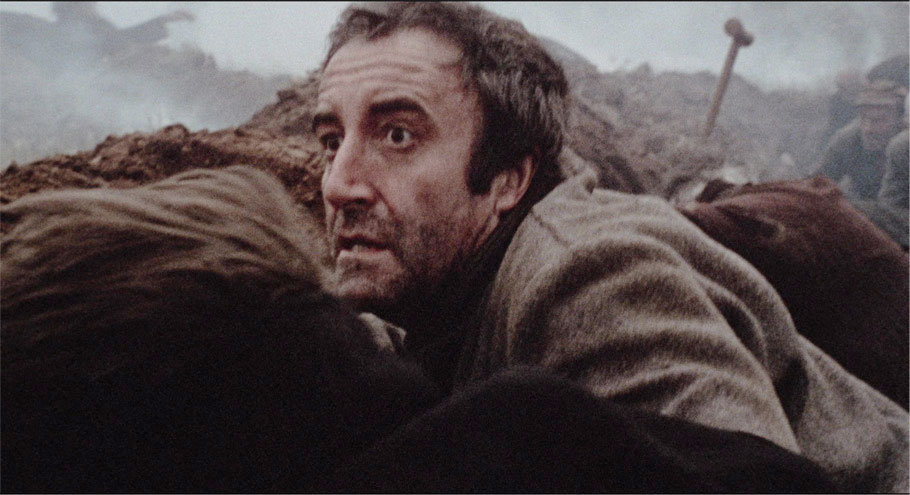
This isn’t to say that the performances were wanting. Each man does a sterling job of convincing us how unusual and how terrible their experience is and every so often Inspector Clouseau says something unremittingly unfunny. Sellers was a first class actor somewhat straitjacketed by being known as his witless police inspector. Clive Rees’ direction is unshowy and the opening action sequence is very well staged and cut. Cinematically you are really buggered by setting 80 per cent of the action entombed in semi-darkness with no hope of escape. But the film does keep you watching. It’s a study of survival in the most extreme of situations. Composer Stanley Myers’ mournful and simple harmonica and snare drum intro and outro serve the film well by bleakly accompanying the opening and closing credits. There’s no score in between. In fact it may seem ridiculous to have a score for such a dark and unrelenting situation.
The Blockhouse is a real oddity, a story that seems to defy any kind of successful visual presentation being predominantly set in a fortified bunker in candlelight. So you could say that director and cast succeeded in making the best film of its kind. It’s very well made, well-acted, completely fascinating but bleaker than the weather outside my window on Boxing Day 2021 in the UK.
Presented in the 1.85:1 aspect ratio with thin letterboxing on standard 16:9 TVs, both available versions have a modicum of dirt and sparkle that doesn’t detract. Grain is always a problem shooting in low light but it’s never distracting. The two presentations (the distributor version at 92 mins and the director’s version, also at 92 mins) feature revised and extended opening and closing captions. In the former, this ‘true’ story of seven men ends with five dead and two survivors as it captions exactly this information at the start. Spoiler a cert. In the latter director’s version, there are no captions at the start (so you can enjoy the unfolding drama, duh…) except to date the action and the truth of the story is revealed at the end (something the distributors thought would be too bleak for audiences). There is a perceptual drop from full HD quality as the Director’s Cut excerpts were only available in standard definition. There is a note to that effect when you come to choose which version to watch.
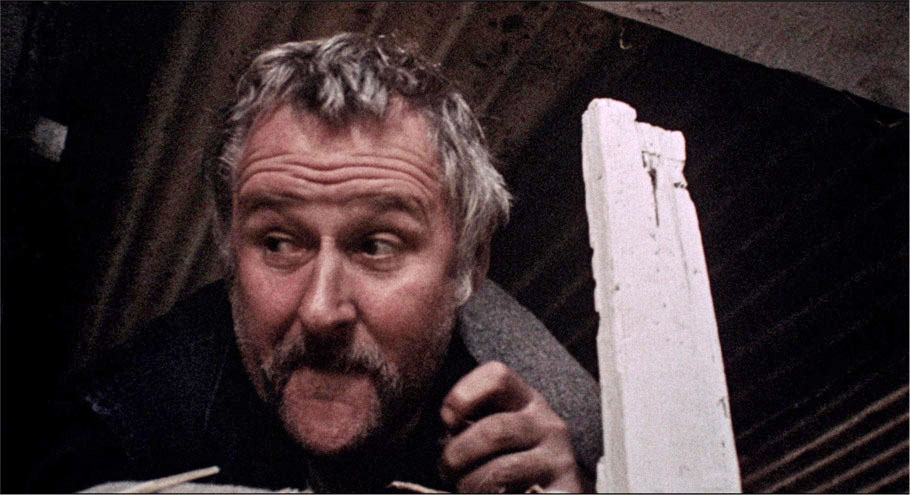
The original mono audio at times felt a little harsh. I noticed this on a first viewing and only later did I find out that the film was one of the first to employ Dolby noise reduction and apparently something didn’t quite turn out right. But it’s a minor quibble as the harshness doesn’t affect intelligibility.
There are new and improved English subtitles for the deaf and hard-of-hearing.
Shots in the Dark (2022): co-star Leon Lissek remembers the highs and lows of filming on the Channel Islands (5’ 45”)
Another unintended (or perhaps not) nod to Inspector Clouseau, A Shot in the Dark being the second film in the Clouseau series. Lissek played Kozhek in the film and his memories of production include how well he got on with Charles Aznavour, how Peter Sellers kept himself to himself and rather shockingly the fact that the actors were not told where the explosions were filming the attack at the start and that the charges were detonated when the effects technicians could see it was safe to do so. Using long lenses foreshortens the actual space and it really does appear like a few people were caught up in one or two detonations.
Out of the Darkness (2022): Fred Rees and Gilda Rees, director Clive Rees’ son and widow, recall the film’s turbulent production history (12’ 52”)
Fred and Gilda Rees give us a potted history of Clive’s career. There’s a lovely Charles Aznavour story in which art triumphs over money. Speaking of money, the production ran out and all the actors except one, said they’d complete the film. In order to stay on, this actor made the production pay a chunk of money to the Hare Krishnas… Is that a give away? That same actor had his own idea of a suitable costume, an opinion not shared by his director. Both wife and son are very relaxed on camera and it’s clear that Clive Rees was much loved. He died in 2020 which is something of a tragedy given the timing of a Blu-ray release of his film.
Underground Filmmaking (2022): producer Kent Walwin on the many challenges of making a low-budget war film (18’ 18”)
Walwin nods at the Sellers/Clouseau problem as well as outlines the commercials background of the director Clive Rees. He talks about the German built underground ‘hospital’, “chiselled in to the rock of Guernsey,” where they shot all the interiors. This hospital was originally built for an altogether more sinister purpose, exterminations after the Nazis had taken the whole of Europe. He touches on the sexual aspects of a society of men alone for years and delivers a gem of a fact about the real event (some of the real victims were found dressed in women’s clothes and tights as those were also stored in the bunker to curry favour with the locals). He tells some pretty hair-raising health stories. A very entertaining and enlightening extra. Nice one Kent.
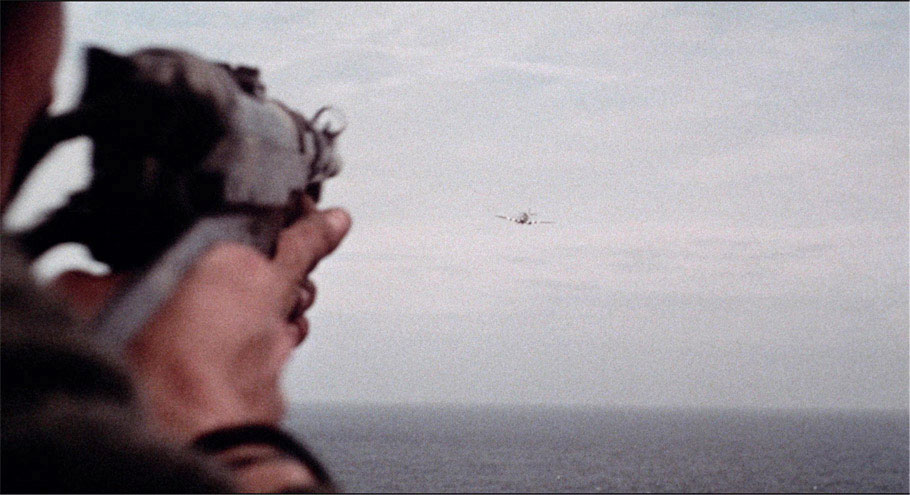
Down to Earth (2022): production manager Matthew Raymond recalls procuring a Spitfire for the opening battle (11’ 47”)
“It was pretty gloomy!” Raymond charts the genesis of the film and the problems getting Spitfires for the aerial bombardment. How production managers did their job before the internet beggars belief. As for the production, “It was a plod, six weeks felt like six months.” I sympathise. Aznavour comes across as charming, again. This is good extra for seeing the production from another point of view. There are some production story gems in here I won’t spoil. Short but packed with detail.
When Lights Go Low (2022): electrician Peter Bloor on the perils of powering a shoot deep underground (9’ 32”)
Bloor gives us the perspective from the crew’s point of view, and again it’s a really refreshing one. At the start he talks about working for Lee Electric and he got on the film because he was part of a popular gaffer’s (chief electrician’s) crew. I wondered as I watched if it was Roy Rodhouse who was the de facto leader of a small crew mutiny on a film I worked on and at the end of the interview, he name checks ‘Roysey Rodhouse’. In my review of Link, I posted a picture of banner that said “We want to work on! We love hamburgers! You can’t do enough for a good Guvnor!” That was Roy Rodhouse’s handwriting! In fact Link was his final film. Bloor’s description of the shoot being ‘fun’ rests completely on the camaraderie of a good crew. You can survive bad conditions with a fine and unrefined sense of humour. And how evocative is the idea that after eight or nine hours underground, you come into the light and the smell of the countryside (like cut grass) was just overpowering.
Image gallery: promotional and publicity material
Here we have 19 black and white production stills, Production Notes from Hemdale and the black and white poster. There’s a grateful thanks to Clive Rees’s family for the material.
The Channel Islands 1940–1945 (1945): short film produced by the Crown Film Unit which sees Channel Islanders re-enact incidents from the German occupation during World War II (16’ 19”)
The first, most striking thing to see in the front credits of this extra is that the editor is credited as a ‘cutter’ which I don’t think I’ve ever seen before and though surprising now, but not in the early days of filmmaking, the editor was a woman, Jocelyn Jackson. In the early days of cinema, putting a film together was seen in a perfunctory light, like knitting and so women did this job until the boys figured out there was some importance and craft in the job, art even. Whoa, this is unexpected. The commentary states then when the Germans arrived in 1940 “…our reaction to them was probably the same as yours would be.” Cut to a man spitting out of his window and a woman slamming hers shut. Cool! I’m not promoting anti-German attitudes but the Nazis were extremely hissable villains in WW II. In fact the whole short is inventively edited and strangely moving. If you shave off the obvious overacting, I’d say that this is a great educational film for youngsters to understand what conditions could like under an invading army. It brings home just how lucky most of us are now in this albeit politically volatile and divided world.
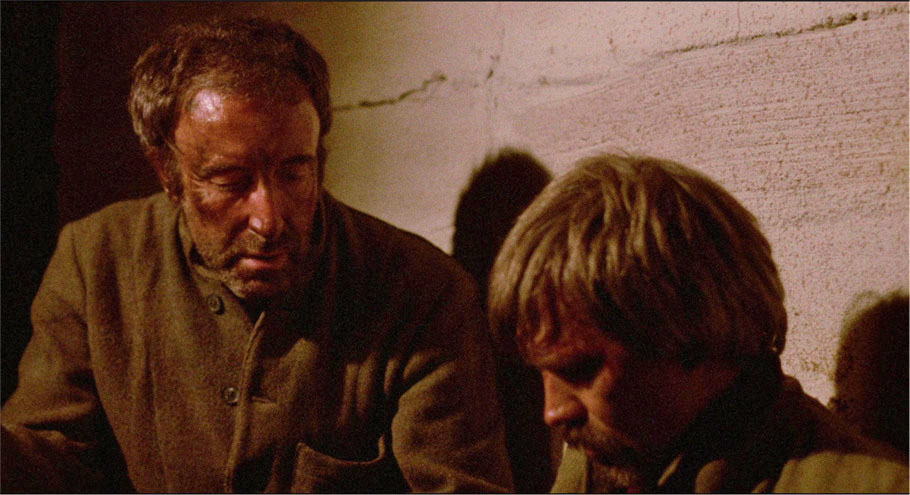
Limited edition exclusive 32-page booklet with a new essay by Kieran Foster, a contemporary news report on the events that inspired the film, archival interviews with star Peter Sellers and director Clive Rees, an overview of contemporary critical responses, new writing on The Channel Islands 1940–1945, and film credits
After the cast and crew credits, Foster’s article, Burying The Blockhouse gives an overview of the path the film took bypassing any significant theatrical release. Foster puts the fate of the film and Peter Seller’s ‘serious’ acting ambitions on a similar footing suggesting the lack of appreciation for both were somehow entwined. For significant background detail on the film, this is the article to go to. Buried Alive For Six Years is the original 1951 news story that the events of The Blockhouse were based on. And it’s a chilling read regardless of the seventy-one years that have passed since the event. The unmentioned tragedy of the news report is that the recovering survivor – headlined as doing well in hospital - must have died hours after the report was written. An Interview with Clive Rees begins with a picture of the director that may lend some credence to nationalities sharing DNA. There aren’t that many Welsh film directors but Rees looks the spitting image of ex-Python and fellow Welshman Terry Jones RIP. The first paragraph describes the island of Bryher in the Channel Islands as the location for Rees’ film the piece was promoting, When The Whales Came. Being someone who has spent many holiday hours on the island, I have to say that Bryher is part of the Scilly Isles west of Land’s End, not the Channel Islands. Ah, I see on page 15 of the booklet, this factual error is corrected. Rees obviously had a very lucrative career – like Ridley Scott and Alan Parker – making commercials. He used his own money to get the ball rolling on funding the few features he made to the tune of £300,000. That was not an insignificant sum in 1989 and it amounts to closer to half a million today. This interview is very light on Rees’ own voice. I count ten sentences over a three page interview. But the piece does have further information not recorded anywhere else in this release.
Sellers’ Market, an interview with the actor for The Guardian newspaper is essentially Sellers giving us an update on his career and how all those serious roles would come flooding in after people see The Blockhouse. Irony, indeed. He also mentions a Kubrick project he was going to be involved with and I cannot even guess what that might have been… Peter Sellers in Napoleon perhaps? Dear God, not another French accent. Teenage Film Producer Is Busy tells the story of the 18 year old Edgar M. Bronfman, son of a wealthy Canadian, the owner of Seagram, the distilling company. The article starts sort of celebratory and then charts a series of missteps until the hilarious final line, “In 2011,he was convicted of insider trading in France.” It almost feels like a punchline. The Critical Response section contains three extracts from reviews by Richard Combs of the Monthly Film Bulletin, Hawk of Variety, and Janet Maslin of the New York Times. The Channel Islands 1940 – 1945 is a one page article on the very impressive short film in the Extras. It notes the dark humour of the film. Then there the technical credits for the restoration. All in all, a fine read throughout.
As Peter Sellers said The Blockhouse is not for your average cinema goer but for “Connoisseurs of Cinema”. It’s a very interesting film with the grimmest of premises (in both senses of the word, idea and location) but it showcases fine acting and it’s always leading you on further into the gloom of these pour souls’ horrendous experiences. That it’s based on a true story makes the tale even more chilling. If you like your cinema offbeat and dark, then The Blockhouse fits your bill.
|